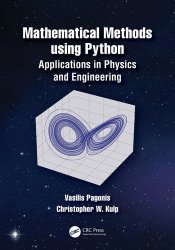 Название: Mathematical Methods using Python: Applications in Physics and Engineering
Название: Mathematical Methods using Python: Applications in Physics and EngineeringАвтор: Vasilis Pagonis, Christopher W. Kulp
Издательство: CRC Press
Год: 2024
Страниц: 505
Язык: английский
Формат: pdf (true)
Размер: 13.6 MB
This advanced undergraduate textbook presents a new approach to teaching mathematical methods for scientists and engineers. It provides a practical, pedagogical introduction to utilizing Python in Mathematical and Computational Methods courses. Both analytical and computational examples are integrated from its start. Each chapter concludes with a set of problems designed to help students hone their skills in mathematical techniques, computer programming, and numerical analysis. The book places less emphasis on mathematical proofs, and more emphasis on how to use computers for both symbolic and numerical calculations. It contains 182 extensively documented coding examples, based on topics that students will encounter in their advanced courses in Mechanics, Electronics, Optics, Electromagnetism, Quantum Mechanics etc.
An introductory chapter gives students a crash course in Python programming and the most often used libraries (SymPy, NumPy, SciPy, Matplotlib). This is followed by chapters dedicated to differentiation, integration, vectors and multiple integration techniques. The next group of chapters covers complex numbers, matrices, vector analysis and vector spaces. Extensive chapters cover ordinary and partial differential equations, followed by chapters on nonlinear systems and on the analysis of experimental data using linear and nonlinear regression techniques, Fourier transforms, binomial and Gaussian distributions. The book is accompanied by a dedicated GitHub website, which contains all codes from the book in the form of ready to run Jupyter notebooks. A detailed solutions manual is also available for instructors using the textbook in their courses.
We chose Python because of its popularity and open source nature. Using Python to perform mathematical calculations is a transferable skill students will find valuable, regardless of what they choose to do with their degree. This book is as much about learning to use Python to solve problems, as it is about learning mathematics. Writing a book intimately tied to a language runs the risk of becoming out of date when the language is updated. However most of the Python commands chosen in this book have been around a long time and are widely used by scientists and engineers. Students who have worked through this book should be comfortable adapting to changes in the Python language as they arise.
Key Features:
· A unique teaching approach which merges mathematical methods and the Python programming skills which physicists and engineering students need in their courses.
· Uses examples and models from physical and engineering systems, to motivate the mathematics being taught.
· Students learn to solve scientific problems in three different ways: traditional pen-and-paper methods, using scientific numerical techniques with NumPy and SciPy, and using Symbolic Python (SymPy).
Скачать Mathematical Methods using Python: Applications in Physics and Engineering